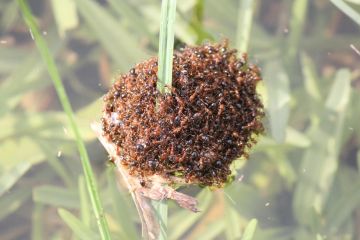The Invasive Species Council is issuing a stark warning to residents in south east Queensland and surrounds, as fire ants are seen forming rafts and spreading amongst flood waters.
‘Fire ants form large floating rafts that move with water currents. Disturbingly, new footage shows this rafting behaviour happening right now in flood-affected areas with high fire ant density like Logan, Scenic Rim and northern Gold Coast,’ Invasive Species Council Advocacy Manager Reece Pianta said.
‘As flood waters recede we are urging the community to look out for and report fire ant nests including in their backyards, local parks, beaches or bushland.
‘This recent heavy rainfall in southern Queensland will spread high-density infestations and concerningly it could sweep fire ants into carrier materials like turf, risking their further spread to other parts of Australia
‘We’re lucky fire ants aren’t in the Murray-Darling basin, but this is the kind of event that could see them spread into New South Wales if they were.
‘It is a timely reminder that the Queensland government must urgently ramp up fire ant suppression.
‘Fire ants are one of the world’s worst super pests and their unchecked spread will result in economic damage greater than that caused by cane toads, rabbits, feral cats and foxes combined.
‘We call on Peter Dutton and Anthony Albanese to commit to an urgent fire ant surge and long-term funding.
‘This isn’t just an election issue for Queenslanders, fire ants will spread to all parts of Australia if eradication fails.
‘An increase in funding now could save Australia billions in fire ant costs each year, not to mention the immeasurable cost to our environment, wildlife and lifestyles.
‘Of course, fire ants are dangerous. Don’t put yourself, clothing or belongings in direct contact with ants or their nests.’
Allenview, Queensland resident Kirsty McKenna (who filmed some of the fire ant rafting) said that it was essential residents received more support to reduce fire ant numbers.
‘I’m worried if we don’t reduce the fire ant infestation, it will undermine Australia’s eradication efforts,’ she said.
‘I’m actively controlling them on my property but the whole community needs to join in and support eradication.
‘There’s lots of turf farms and hay operations near me and if they get in there I also worry they will spread to other parts of the country.’
Residents are encouraged to check their properties for fire ants as south east Queensland’s flood waters recede.
If you think you have spotted fire ants report them to fireants.org.au.
Media inquiries: (02) 8006 5004
Videos of fire ants rafting in current Qld floodwaters are available here.
Background:
- Fire ants are dark reddish-brown with a darker black-brown abdomen and range in size from two to six millimetres long. Their ant nests are distinctive mounds of loose, crumbly or fluffy-looking soil with a honeycomb appearance, up to 40 centimetres high, with no obvious entrance holes.
- Red imported fire ants can damage electrical and agricultural equipment, sting people, pets and livestock, kill native plants and animals, and damage ecosystems beyond repair.
- A ten-year proposed eradication program has been developed, so far it is only funded until 2027 at $592 million – well short of what is required for full eradication.
- The 2021 National Red Imported Fire Ant Eradication Program strategic review estimated that at least $200 to $300 million per year will be required for ongoing eradication efforts to achieve eradication by 2032.
- Fire ants can be lethal to humans, are expected to exceed $2 billion per year in economic impacts on Australia’s economy and if they get out of control, will devastate wildlife, cut agricultural output by up to 40% and may cause over 650,000 extra medical appointments each year.
- Fire ants can form rafts during flood events, stowaway in freight or soil, or spread by Queen ant flights of up to several km.
- Fire ants came into Australia in the late 90s in freight from the United States, they were found in 2001. Fire ants are originally from South America.
- Fire ants have spread across most of the southern United States, and are spreading in China at a rate of about 80 km per year. Australia has managed to contain fire ants in south east Queensland for 20 years however under-resourcing has prevented successful eradication.
- Almost all of Australia is climatically suitable for fire ants.









